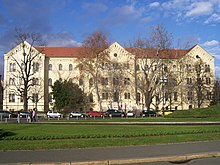
Zagreb is the capital and largest city of Croatia. It is in the north of the country, along the Sava river, at the southern slopes of the Medvednica mountain. Zagreb stands near the international border between Croatia and Slovenia at an elevation of approximately 158 m (518 ft) above sea level. In 2018, the population of the Zagreb urban agglomeration was 1,271,150, between a quarter and a third of the total population of Croatia, while at the 2021 census, the city itself had a population of 767,131.
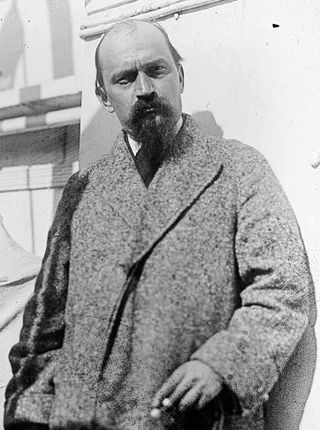
Ivan Meštrović was a Croatian and Yugoslav sculptor, architect, and writer. He was the most prominent modern Croatian sculptor and a leading artistic personality in contemporary Zagreb. He studied at Pavle Bilinić's Stone Workshop in Split and at the Academy of Fine Arts Vienna, where he was formed under the influence of the Secession. He traveled throughout Europe and studied the works of ancient and Renaissance masters, especially Michelangelo, and French sculptors Auguste Rodin, Antoine Bourdelle and Aristide Maillol. He was the initiator of the national-romantic group Medulić. During the First World War, he lived in emigration. After the war, he returned to Croatia and began a long and fruitful period of sculpture and pedagogical work. In 1942 he emigrated to Italy, in 1943 to Switzerland and in 1947 to the United States. He was a professor of sculpture at the Syracuse University and from 1955 at the University of Notre Dame in South Bend, Indiana.
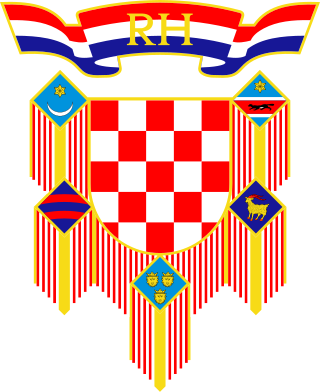
The president of Croatia, officially the president of the Republic of Croatia, is the head of state, commander-in-chief of the military and chief representative of the Republic of Croatia both within the country and abroad. The president is the holder of the highest office in Croatia. However, the president is not the head of the executive branch as Croatia has a parliamentary system in which the holder of the post of prime minister is the most powerful person within the country's constitutional framework and everyday politics.
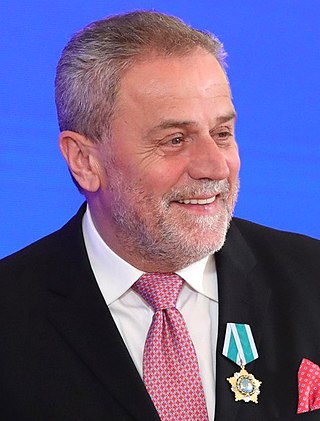
Milan Bandić was a Croatian politician and the longest-serving mayor of Zagreb, the capital of Croatia. Bandić was mayor almost continuously from 2000 to 2021, except during the time between his resignation in 2002 and the 2005 election. He was also suspended from exercising his powers and duties for several months after his 2014 arrest over a corruption scandal. Out of Bandić's multifaceted engagement in politics, the most noted part was his mayoralty of Zagreb, which followed the Croatian Democratic Union's (HDZ) first post-socialist period of government (1990–2000), and exacerbated many existing transitional problems in the city.
The Yugoslav Cup, officially known between 1923 and 1940 as the King Alexander Cup (Serbian: Куп краља Александра; Croatian: Kup kralja Aleksandra, and between 1947 and 1991 as the Marshal Tito Cup, was one of two major football competitions in Yugoslavia, the other one being the Yugoslav League Championship. The Yugoslav Cup took place after the league championships when every competitive league in Yugoslavia had finished, in order to determine which teams are ranked as their corresponding seeds. The Marshal Tito Cup trophy was based on a design by Branko Šotra.

The Croatian National Theatre in Zagreb, commonly referred to as HNK Zagreb, is a theatre, opera and ballet house located in Zagreb.
Biskupija is a village and municipality in Šibenik-Knin County, Croatia. The seat of the municipality is the village of Orlić.

Gradec, Grič or Gornji Grad is a part of Zagreb, Croatia, and together with Kaptol it is the medieval nucleus of the city. It is situated on the hill of Grič. Today this neighbourhood forms part of the Gornji Grad-Medveščak district.

The Art pavilion in Zagreb is an art gallery in Zagreb, Croatia. The pavilion is located on the Lenuci Horseshoe, Lower town area of the city, south of Nikola Šubić Zrinski Square, on the northern side of the King Tomislav Square which flanks the Zagreb Central Station. Established in 1898, it is the oldest gallery in the Southeast Europe and the only purpose-built gallery in Zagreb designed specifically to accommodate large scale exhibitions.
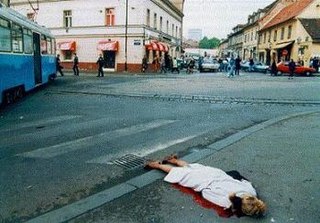
The Zagreb rocket attacks were two rocket attacks conducted by the Army of the Republic of Serbian Krajina that used multiple rocket launchers to strike the Croatian capital of Zagreb during the Croatian War of Independence. The attack killed seven and wounded over 200 Croatian and foreign civilians and was carried out on 2 May and 3 May 1995 as retaliation for the Croatian army's offensive in Operation Flash. The rocket attacks deliberately targeted civilian locations. Zagreb was the largest of several cities hit by the attack. It was not the only instance in the war in Croatia that cluster bombs were used in combat.

Rudolf barracks is historic army barracks site in Zagreb, Croatia, today serving for various public purposes.

Congress Square is one of the central squares in Ljubljana, the capital of Slovenia. In the late 1930s, the square was renovated by the prominent Slovene architect Jože Plečnik. Since August 2021, it has been inscribed as part of Plečnik's legacy on the UNESCO World Heritage List.
Uz Maršala Tita is a Yugoslav Partisan anthem about the leader of the country's liberation movement in World War II, Josip Broz Tito, written by Vladimir Nazor and composed by Oskar Danon.
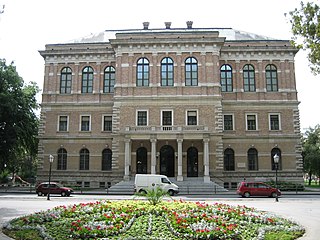
The Strossmayer Gallery of Old Masters is a fine art museum in Zagreb, Croatia exhibiting the collection donated to the city by Bishop Josip Juraj Strossmayer in 1884. Located at 11 Nikola Šubić Zrinski Square, it forms part of the Croatian Academy of Sciences and Arts.

Nikola Šubić Zrinski Square is a square and park in Donji Grad, the central part of Zagreb, the capital of Croatia. It is located near the central Ban Jelačić Square, halfway towards the Main Railway Station. It is a part of the Green horseshoe or Lenuci's horseshoe, which consists of seven squares in Donji grad. It is spread over an area of 12,540 square meters (135,000 sq ft).

Hönigsberg & Deutsch was an architecture studio and construction company formed in Zagreb by architects Leo Hönigsberg and Julio Deutsch, active between 1889 and 1911. They produced over 90 known works in the Lower Town area of Zagreb, built during the redevelopment in the years following the 1880 Zagreb earthquake. The majority of these were residential houses, but they also designed manufacturing plants, synagogues and public institution buildings.

The Lenuci Horseshoe or the Green Horseshoe is a U-shaped system of city squares with parks in downtown Zagreb, Croatia. The horseshoe was conceived in 1882 by Croatian urbanist Milan Lenuci. The parks were designed between 1883 and 1887, at a time when today's Donji grad formed the southern outskirts of Zagreb. The construction was helped by the efforts to rebuild the city after the 1880 Zagreb earthquake, and in 1889 the entire horseshoe was finished—its two ends were connected by the newly built Zagreb Botanical Garden. The park system consists of seven squares aligned on three straight lines.
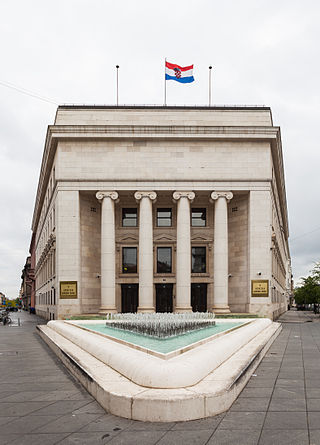
Croatian Nobles Square is one of the central squares in Zagreb. It was designed in 1923 urban plan as entry to the then new eastern part of the town. Draškovićeva street is on the western side of the square, Martićeva street begins on the north side, while a road and tram line go through the middle of the square to the Rački street and Square of the Victims of Fascism.
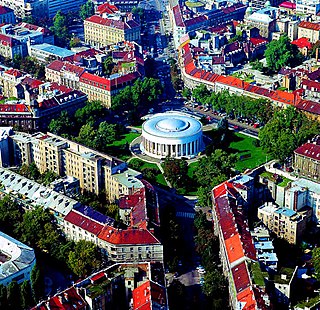
Square of the Victims of Fascism is one of the central squares in Zagreb. It was designed in 1923 urban plan on the site of the former fairground that was east of Draškovića street as the new center of then new eastern part of the town that was deliberately and systematically built in the 1920s and 1930s.


